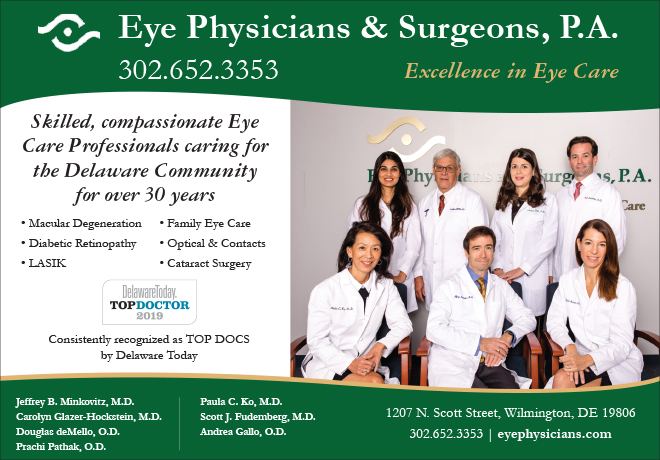Dry Eye: It Should Be Treated

By Jeffrey B. Minkovitz, M.D.
Dry eye is one of the most common eye conditions. It is not only bothersome, but it can cause significant damage if left untreated. Proper diagnosis can also lead to discovery and treatment of other related conditions in the body. Simply defined, dry eye is a condition in which one’s natural tears do not adequately lubricate the eyes to keep them comfortable and healthy. Symptoms may include stinging, burning or scratchy feeling, as well as light sensitivity, blurring and eye fatigue. Ironically, dry eye induced irritation may also cause excessive compensatory tearing.
Dry eyes may be caused by either insufficient tear production or excessive tear evaporation. Diminished tear production (aqueous deficiency) is commonly caused by aging, more common over 50, hormonal changes, especially in women, drugs such as antihistamines and certain blood pressure medications, medical conditions including rheumatoid arthritis and sjogrens syndrome, and occasionally trauma or laser vision correction (especially when done with LASIK flaps – one reason I have transitioned to laser vision correction WITHOUT FLAPS). Excessive tear evaporation may be environmental (dry heat in the winter, or air blowing directly on the eye), behavioral/structural (poor blinking due to lid abnormalities, sleeping with eyes slightly open, or failing to blink while concentrating for long periods of time reading or in computer work) or due to an imbalance in the tear composition. The normal tear film has three important layers (watery, oily and mucus). Correct balance is required to ensure adequate wetting, good tear spread, and slower evaporation from the surface of the eye.
In addition to discomfort, dry eye can cause blurry vision, infection, abrasions, inflammation (which causes further damage), and scarring of the surface (which can lead to permanent vision loss). Dry eyes can also complicate planned ocular surgeries performed for other reasons, such as cataract and refractive surgery.
Testing for dry eyes is important not only to properly diagnose and guide treatment, but also to identify possible systemic diseases, (diseases in the body) which may be associated. These conditions include rheumatoid arthritis, sjogrens syndrome, and other autoimmune and collagen vascular diseases such as lupus. Evaluation includes a careful patient history, examination of the ocular surface (with special dyes testing for damaged surface cells), and if indicated a measurement of tear volume and production. Recently, several new tests have been developed including tear osmolarity and measurements for inflammatory markers associated with dry eye. These tests may further assist in directing treatment.
Treatment options include environmental and behavioral changes (humidifiers, avoiding wind or direct exposure, taking breaks from extended periods of reading/computer work, smoking cessation), instilling artificial tears (choices dictated by disease severity and type (aqueous deficient or evaporative), plugging tear ducts (to keep tears in contact with the eye longer), anti-inflammatory medication (steroid drops or Restasis), omega 3 fatty acid pills and diet, special therapeutic contact lenses, and several other less common options for severely affected patients.
Although often overlooked or disregarded when compared to “more serious” ocular conditions such as cataract, macular degeneration, and diabetic retinal disease, dry eye is one of the most common ocular diseases and can profoundly affect ocular comfort and visual performance. Regular examinations are a valuable way to screen for this and other conditions.
Bio
Jeffrey Minkovitz, MD is an ophthalmologist with Eye Physicians and Surgeons in Wilmington, specializing in cataract surgery, laser vision correction, and corneal diseases. He trained at Harvard, University of Massachusetts, Washington University, and Johns Hopkins’ Wilmer Eye Institute. He participated in the early research on PRK laser vision correction which led to FDA approval in 1994, performed the first Delaware laser treatment in 1995, and has since performed thousands of eye surgeries. Recognized for several Delaware “firsts,” in addition to laser vision correction, Dr Minkovitz introduced near vision CK (to reduce the need for reading glasses), DSAEK, DMEK and DALK (less invasive methods of corneal transplantation), and laser assisted cataract surgery. Dr Minkovitz is on staff at Christiana Care, and is co-founder of the Center for Advanced Surgical Arts, where he serves on the medical advisory board. In 2016, he founded Laser Vison Delaware, the First State’s newest laser vision correction center with the latest advanced technology. Dr Minkovitz has been a speaker at the annual meeting of the American Academy of Ophthalmology, and received the Outstanding Teaching Award from residents at Wilmer Eye Institute. He has been voted by his peers a Top Doc in Ophthalmology in Delaware Today Magazine for more than 8 years, most recently in 2019.


